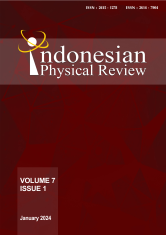PROVENANCE ANALYSIS OF THE RAMPONG FORMATION SANDSTONE IN THE KETUKAH AREA, GAYO LUES, ACEH
DOI:
10.29303/ipr.v7i1.261Downloads
Abstract
The research location is in Ketukah, Gayo Lues Aceh, which is composed of the Late Oligocene to Early Miocene Rampong Formation. Lithology includes sandstones, conglomerates, and mudstones. The study aims to determine the origin of the sandstones in the Rampong Formation. Provenance studies are beneficial in providing information for oil and gas exploration. The analysis is critical for understanding the sediment transport channel, the overall depositional pattern of the basin, and predicting the location of sand bodies in the basin. Because the Rampong Formation is located in the North Sumatra Basin, the availability of provenance information is useful in efforts to search for oil and gas potential in the future. In this research, we restrict the study to the provenance, which includes the tectonic setting, origin rock, and paleoclimate where these sandstones originate. The methods are geological mapping and petrographic analysis. In petrographic analysis, we use JMicrovision to calculate mineral composition. The results showed that the sandstones of the Rampong Formation are arenite sandstones, especially sub-arkosic and sub-lith arenite. They originate from a tectonic setting known as a recycled orogen, related to the subduction of Eurasia and the Indo-Australian plates. The sandstones were formed from granite that had undergone low metamorphism in the Late Cretaceous to the Eocene period. In addition, the paleoclimate is humid.
Keywords:
Rampong Formation provenance petrography sandstoneReferences
N.R. Cameron, J. D. Bennett, D. McC Bridge, M. C. Clarke, A. Djunuddin, S. A. Ghazali, H. Harahap, D. H. Jeffery, W. Kartawa, W. Keats, H. Ngabito, N. M. Rocks, and S. J. Thompson. “Geological Map Of The Takengon Quadrangle, Sumatera.†Bandung: Geological Survey Institute, 2007.
R. W. Bemmelen, “The Geology of Indonesia,†New York: U.S. Government Printing Office, 1949.
F.J. Pettijohn, P.E. Potter, R. Siever, “Sand and Sandstone,†New York: Springer, 1987.
W.R. Dickinson and C. Suzcek, †Plate tectonic and sandstone compositions,†The American Associations of Petroleum Geologists Bulletin, vol. 63, pp. 2164-2182, 1979.
Z. Zhang and H. Wang, “Comprehensive provenance analysis and its applications to Eocene Clastic Rocks in the Huimin Depression, Bohai Bay Basin, China.†Journal Minerals, vol. 9, 2019.
G. S. Nugraha, E. Sunardi, I. Haryanto, B. G. Adhiperdana, R. Fakhruddin, R. Fitriany, D. Gunarsih, “ Facies analysis, biostratigraphy, and provenance of the late Neogene Seulimeum Formation, Northwest Aceh basin, Sumatra (Indonesia).†Journal Heliyon, vol 9, 2023.
A. J. Barber, M. J. Crow, and J. S. Milsom, “Sumatra: Geology, Resources and Tectonic Evolution,†London: Geological Society, 2005.
M. S. Rosid, N. N. Tullailah, and R. A. Wibowo, “Identification of potential hydrocarbon traps in area X pre-tertiary sediments of the North Sumatra basin using gravity and seismic data,†Journal UNNES, vol 10, 2020.
R. L. Folk, “Petrology of Sedimentary Rocks,†Texas: Hemphill Publishing Company, 1979.
A. Basu, S.W. Young, L. J. Suttner, W. C. James, G. H. Mack, “Re-evaluation of the use of undulatory extinction and polycrystallinity in detrital quartz for provenance interpretation.†Journal of Sedimentary Research, vol. 45, pp. 871-882, 1975.
W. R. Dickinson, “Interpreting provenance relations from detrital modes of
sandstones.†In: Provenance of Arenites, Dordrecht: Springer, 1985, pp. 333-361.
M. E. Tucker, “Sedimentary Petrology.†United Kingdom: Blackwell Science, 2001.
W. S. MacKenzie, A. E. Adams, and K. H. Brodie. “Rocks and Minerals in Thin Section.†London: CRC Press.
S. Boggs, “Petrology of Sedimentary Rocks.†New York: Cambridge University Press, 2009.
M. L. Larrea, S. M. Castro, E. A. Bjerg, “A software solution for point counting. Petrographic thin section analysis as a case study,†Arabian Journal Geoscience, 2013.
F.J. Pettijohn, “Sedimentary rocks,†New York: Harper & Row, 1975.
W. R. Dickinson, L. S. Beard, G. R. Brakenridge, J. L. Erjavec, R. C. Ferguson, K. F. Inman, R. A. Knepp, F. A. Lindberg, P. T. Ryberg, “Provenance of North American Phanerozoic sandstones in relation to tectonic setting,†Geological Society of American Bulletin, vol. 94, p. 222-235, 1983.
S. A. Nelson, “Petrology Sandstone and Conglomerate,†New Orleans: Tulane University, 2007.
A. Tortosa, M. Palomares, dan J. Arribas, “Quartz grain types in Holocene deposits from the Spanish Central System: some problems in provenance analysis,†Geological Society, vol 57, pp. 47-54, 1991.
B. Ahmer dan S. K. Muhammad, “Petrography and provenance of sandstone and studies of shale of Kuldana formation, Kalamula and Khursheedabad area, Kahuta,†Azad Kashmir Earth Sci. Malaysia (ESMY), vol. 1 (1), pp. 21-31, 2017.
W. L. Brown dan I. Parsons, “Feldspars in Igneous Rocks,†In Parsons, I. (eds) Feldspars and their Reactions. NATO ASI Series, vol 421. Dordrecht: Springer, 1994.
License

This work is licensed under a Creative Commons Attribution-NonCommercial-ShareAlike 4.0 International License.
Authors who publish with Indonesian Physical Review Journal, agree to the following terms:
- Authors retain copyright and grant the journal right of first publication with the work simultaneously licensed under a Creative Commons Attribution-ShareAlike 4.0 International Licence (CC BY SA-4.0). This license allows authors to use all articles, data sets, graphics, and appendices in data mining applications, search engines, web sites, blogs, and other platforms by providing an appropriate reference. The journal allows the author(s) to hold the copyright without restrictions and will retain publishing rights without restrictions.
- Authors are able to enter into separate, additional contractual arrangements for the non-exclusive distribution of the journal's published version of the work (e.g., post it to an institutional repository or publish it in a book), with an acknowledgment of its initial publication in Indonesian Physical Review Journal.
- Authors are permitted and encouraged to post their work online (e.g., in institutional repositories or on their website) prior to and during the submission process, as it can lead to productive exchanges, as well as earlier and greater citation of published work (See The Effect of Open Access).





